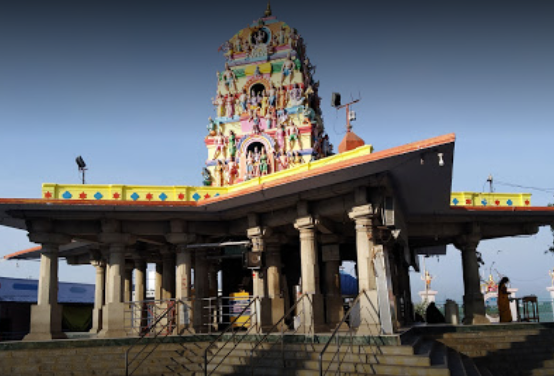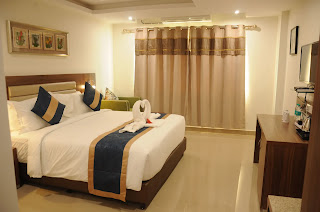 |
| Main Temple Tower of Mallikarjuna temple |
 |
| Lord Mallikarjuna |
 |
| Temple tower of Mallikarjuna temple |
 |
| Carvings in Mallikarjuna temple |
 |
| carvings on walls in Mallikarjuna Temple |
 |
| Lord Nandiswara |
 |
| Sculp;tures in Bhramaramba temple |
 |
| Goddess Bhramaramba |
 |
| Goddess Bhramaramba sculpture |
 |
| Lord Veerabhadra near Mallikarjuna temple |
 |
| Sakshi Ganapati |
 |
| Paladhara-Panchdhara |
 |
| Patalaganga Dam |
Srisailam is located at a distance of
240 kms from Hyderabad and 180 kms from Kurnool. The nearest railway station is
Markapur railway station at a distance of 82kms. We started from Hyderabad and
went through by-pass roads via Jedcherala, Dindi and Mallapur. The road from
Hyderabad to Dindi is very smooth and one can travel comfortably well. Later
the road becomes narrow within many curves and bends. One can see many small
villages and dry lands. As one goes further the forest area comes before with
many baboo bushes and bulky trees with wide spread-branches. Everywhere you see
boards with figures of tiger to warn the passengers about wild animals. We did
not see any wild animals on the road except hordes of monkeys playing on the
branches of the trees. This ghat road is open from 6.00 a.m., to 9.00 p.m. In small cottages we saw the tribal people
called Chenchus who collect wild honey and make various products like mats, chairs
and baskets with bamboo stems. We
stopped at Mrigavani, a restaurant located in Mannanur (75kms from Srisailam)
in midst of forest, to have our buffet- lunch. This is the last place where one
can get good food.
Just three
kms before entering Srisailam, we had darshan of Sakshi Ganapati. Here the lord
is believed to keep attendance of pilgrims who come here. He acts as Sakshi or
witness. Lord Ganesha holds a book in the left hand and a pen in the right
hand. In Srisailam, we were provided accommodation in Ganga Sadan. We went to
the temple directly to have darshan. The temple is built on the top of the
Nallamala Hills situated on the banks of River Krishna. This hill is called Srigiri or Sriparvatham.
References about this temple are seen in Mahabharata and Skanda Puranam.
Mention about this temple is seen in Nasik inscription of Vasishtiputra
Pulumavi of the first century. The IKshvakus ruled Srisailam from 200-300 A.D.
Vishnukundin kings also were the devotees of Sri Mallikarjuma Swamy.
The sanctum of Lord Mallikarjuna is considered
the oldest in the temple dating back to seventh century. In 6th
century the Kadamba king Mayura Sharma described Srisailam as Sriparvatam. The Kakatiya
king along with his wife visited Srisailam and performed Tulabhara. The Reddy
rulers of the 13th century developed Srisailam. Anavema Reddy built Veera Shiromandapam. In 1405 Katyavema Reddy laid steps to Srisailam
and Pedakomati Vema Reddy laid steps to Patalaganga. Among Vijayanagara kings,
Harihararaya II (1342-1404) constructed the main hall of the main temple and his wife
Vitalamba laid steps to Patalaganga.
This temple has four entrances with four
towers or gopuras. The eastern entrance is the main dwaram. Among them, three
towers were built by Vijayanagara Kings. The northern tower was constructed by
Shivaji who visited this temple and worshipped the Goddess. The vimana over the
sanctum was a gold-plated nine-tiered structure with a Poorna Kumbha and an
eight-petalled lotus below it. Four Nandi statues are seen on the four corners
below the superstructure.
The temple
timings are from 4.30 a.m. to 10.00 p.m. Luckily there was no rush. We have availed
atiseeghra darshanam by paying 300/- per head. The timings for this are between
6.00 a.m. to 3.30 p.m. and from 600 p.m. to 10.00 p.m. The Nandi mandapam
looked impressive with a huge statue of Nandi just in front of the Veerasiro Mandapam.
On the ceiling of Nandimandapa one can see the unique carving of Shiva and
Parvati riding on a bull surrounded by Dikpalakas (Lords of eight directions)
on their respective Vahanas.
The
Veerasiro Mandapam was built by Reddy ruler Anavema reddy in 1378. As per Veera Saiva tradition, the devotees
used to offer their heads, hands and tongue as mark of their devotion in olden
days. The Mukha Mandapam was constructed by the Vijayanagara King Harihara Raya
in 1405. In the Garbhalaya, one can see the tiny Jyothirlingam of 25cms in
height with a circular stone platform (panavattam) around.
Here the
Lord is called Mallikarjuna as He was worshipped with jasmine flowers by a
princess called Chandravati. Mallika is another name for Parvati while Arjuna
means Shiva. Lord Shiva here is considered as one of the self-manifested twelve
Jyotirlingams. One can do Abhishekam in person by Paying Rs.1500/-couple.
Abhishekam timings are 6.00 a.m. to 8.0o0 a. m in the morning and from 4.00
p.m. to 5.00 p.m. in the evening. For Sparsha Darshan, one has to book tickets
priced at Rs.500/. Just before entering the sanctum, we can see Ratnagarbha
Vinayaka made of red stone. The sculptures of two dwarapalakas are seen in the
entrance hall or Antarala. Several forms of Shiva are carved one above the
other on the pillars. This inner sanctum was constructed by the queen
Mailamaba, Sister of Kakati Ganapatideva in 1220-1230 A.D.
Later we
went to have darshan of the Goddess Bhramaramba, on the western side of the
main temple. This is the sixth
Shaktipeetha where the neck of Sati devi fell. According to legends, Goddess
Bhramaramba killed the demon Arunasura by sending thousands of bees. In
entrance hall or Mukha Mandapa of this temple, there are many pillars with
beautiful sculptures like hunting on elephants, dancing girls and musicians. At the
interior center of Mukha Mandapa, a stone Sree Chakram is seen installed by Sri
Sankaracharya. In the inner sanctum, the Goddess Bhramaramba is seen gilded
with silver plates. She is seen in a standing posture with eight hands with a
trident in her right hand killing Mahishasura.
On the temple tower images of various forms of Shakti and lions are
seen. In front of this temple there are many mandapas with an interior court
yard below. We can see many forms of Shiva like Uma Maheshwara,
Arthanarishwara, Rajarajeshwara, Nava Brahma Lingas, Virabhadra and Kumara
Swamy in a row including Vriddha Mallikarjuna, the oldest Shiva Lingam
Installed here. We can see the folds and wrinkles on this Shiva Lingam
suggesting its primitive age. Sahasralingam was installed here by Lord Sri
Ram. Devotees are not allowed to exit from this way. They have to move all the
way back to the temple of Bhramaramba, which seems very inconvenient. As there
was a heavy downpour, we were all drenched while going back. This problem can
be easily solved if temple authorities provide an exit from inner courtyard
also. Elderly people may find it difficult to go in the long queue and climb the
steps at various levels; so it would be better if a shorter route and easy
access is provided to them just like in Tirumala temple.
There are many other
pilgrimage spots around this temple such as Hatakeshwaram, Pala Dhara-Pancha
Dhara, Akka Mahadevi caves and Shikareshwaram. To reach Patala Ganga one has to
go down nearly five hundred steps. Now ropeway facility is provided from
Haritha hotel to reach Patala Ganga. Chenchulakshmi
Tribal Museum and Rajeev Gandhi Wild Life sanctuary are also other worthseeing
places. Srisailam hydro-electric project or dam is nearly 15kms from the temple.
There is bus facility to go there from Srisailam. One can experience the scenic beauty of
Nallamala forests and look at the beautiful sculptures of the temples and the
gushing waters of the Krishna waters from the dam site as well.
***********************************
23rd December,2022 Somaseshu Gutala







.png)












































